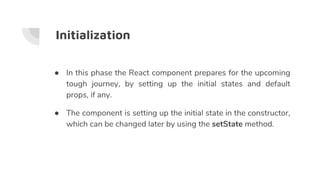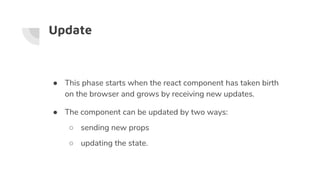React-JS Component Life-cycle Methods
- 1. ReactJs Component Lifecycle Methods By: Chavan Ankush S.
- 2. What is lifecycle methods and why it is important? ● Around us everything goes through a cycle of taking birth, growing and at some point of time it will die. ● Consider trees, any software application, yourself, a div container or UI component in a web browser, each of these takes birth, grows by getting updates and dies. ● The lifecycle methods are various methods which are invoked at different phases of the lifecycle of a component.
- 3. Four phases of a React component ● The React component goes through the following phases ○ Initialization ○ Mounting ○ Update ○ Unmounting
- 4. Visual representation of the phases and the methods of ReactJs lifecycle.
- 5. Initialization ● In this phase the React component prepares for the upcoming tough journey, by setting up the initial states and default props, if any. ● The component is setting up the initial state in the constructor, which can be changed later by using the setState method.
- 6. Mounting ● After preparing with basic needs, state and props, our React Component is ready to mount in the browser DOM. ● This phase gives hook methods for before and after mounting of components. ● The methods which gets called in this phase are ○ componentWillMount() ○ render() ○ componentDidMount()
- 7. Mounting conti….. ● componentWillMount() ○ This method is executed just before the React Component is about to mount on the DOM. ○ This method is executed once in a lifecycle of a component and before first render. ○ Usage: This method is used for initializing the states or props,there is a huge debate going on to merge it with the constructor.
- 8. Mounting conti….. ● render() ○ This method is mounts the component onto the browser. ○ This is a pure method, which means it gives the same output every time the same input is provided.
- 9. Mounting conti….. ● componentDidMount() ○ This this is the hook method which is executed after the component did mount on the dom. ○ This method is executed once in a lifecycle of a component and after the first render. ○ As, in this method, we can access the DOM ○ Usage: this is the right method to integrate API
- 10. Update ● This phase starts when the react component has taken birth on the browser and grows by receiving new updates. ● The component can be updated by two ways: ○ sending new props ○ updating the state.
- 11. Update Conti…... ● sending new props ○ The methods which gets called in this phase are : ■ componentWillReceiveProps() ■ shouldComponentUpdate() ■ componentWillUpdate() ■ render() ■ componentDidUpdate()
- 12. Update Conti…... ● componentWillReceiveProps() ○ This method gets executed when the props have changed and is not first render. ○ Sometimes state depends on the props, hence whenever props changes the state should also be synced,This is the method where it should be done. ○ Usage: This is how the state can be kept synced with the new props.
- 13. Update Conti…... ● shouldComponentUpdate() ○ This method tells the React that when the component receives new props or state is being updated, should React re-render or it can skip rendering? ● componentWillUpdate() ○ This method is executed only after the shouldComponentUpdate() returns true ○ This method is only used to do the preparation for the upcoming render, similar to componentWillMount() or constructor.
- 14. Update Conti…... ● render() ○ This method is mounts the component onto the browser ● componentDidUpdate() ○ This method is executed when the new updated component has been updated in the DOM. ○ This method is used to re trigger the third party libraries used to make sure these libraries also update and reload themselves.
- 15. Update Conti…... ● updating the state ○ The methods which gets called in this phase are : ■ shouldComponentUpdate() ■ componentWillUpdate() ■ render() ■ componentDidUpdate()
- 16. Unmounting ● In this phase, the component is not needed and the component will get unmounted from the DOM. ● The method which is called in this phase : ○ componentWillUnmount()
- 17. Unmounting Conti…. ● componentWillUnmount ○ This method is the last method in the lifecycle. ○ This is executed just before the component gets removed from the DOM. ○ Usage: In this method, we do all the cleanups related to the component. ■ For example, on logout, the user details and all the auth tokens can be cleared before unmounting the main component.
- 18. Any Question ?
- 19. Thank you...



















